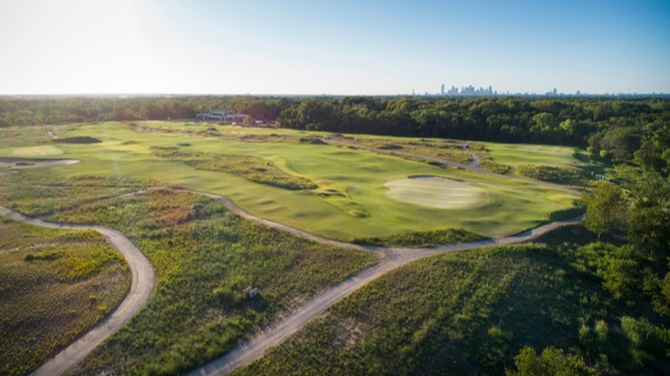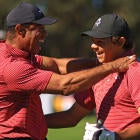I am not a golf architecture-phile. The Spirit of St. Andrews does not sit by my bedside, and I do not get emotionally worked up over the way certain holes are constructed compared to others. While I appreciate the way guys like Geoff Shackelford, Zac Blair and Andy Johnson shape the conversation about course architecture for the layperson (me) in 2018, it's just never been a rabbit hole I've gone down.
And yet, I still understand a fundamentally tremendous course when I see one. That's sort of the thing about great courses. Architecture nerds adore them because they understand what went into making them. The rest of us love them because they're endlessly interesting to play.
When I teed it up on Monday at Trinity Forest on the south side of Dallas, which is the new home of the AT&T Byron Nelson, I was floored by the nuance of the place and the creativity it demanded. You could play it 1,000 times in a year in 1,000 different ways. It may or may not be architecturally sound -- Johnson told me that it is -- but I know it's a course I want to play again.
Trinity Forest was built on top of a landfill south of downtown in a location that makes most locals say, "Wait, where?" It's a reasonable question. I've lived in Dallas for nearly a decade and never even come all that close to driving past this area. And yet, Bill Coore and Ben Crenshaw have constructed an amazing golf course in a minuscule amount of time with every feasible constraint trying to keep them from doing so.
"We've borrowed ideas from the old architects such as Donald Ross, [A.W.] Tillinghast and Perry Maxwell, and they all basically have the same interwoven philosophies in that the holes must fit the ground," co-designer Ben Crenshaw told Jonathan Wall of PGATour.com.
"Perry Maxwell had some fascinating statements about that. He said, if you take a piece of land and tie it into a natural theme, your golf course will be different than anyone else's. I always thought that was a fascinating statement. So wherever we go, we try as hard as we can to not alter the land so much."

I won't go deep on the structure of the design because I'd just be making a fool of myself, but I will say there are three characteristics that really stood out to me about this track compared to other PGA Tour venues.
- The greens flow into the tee boxes: There is no difference between the grass around the greens and the next tee box. It all looks the same. This is part of why the place feels so links-y, and it allows the tournament to put tee boxes pretty much wherever they want on every hole (which I also love). This is also going to make crowd control and flow pretty interesting.
- Every hole is unique: I think when people see links-style courses they think every hole looks the same. If you actually play the course, though, that's far from the case (on a well-designed track).
- All the combinations: We played cart path only on Monday, and I took 2-3 clubs to nearly every shot. You can feasibly play the entire place with a 4-iron and a putter and probably score pretty well. You could also play it with a driver, 8-iron and a putter and also score well. I putted from chipping areas and chipped from putting areas. I hit 7-irons when I maybe should have hit 3-woods. I had to (at least try to) draw and fade the ball on every hole, and I could go back again and play it the other way just as well (or as poorly). I don't know if architecture folks think this is a good thing, but I loved it. It demands more of you than to just see how far you can hit it, go find it and see how far you can hit it again.
The entire course reminded me of a more natural, less over-the-top Chambers Bay. I sort of liked Chambers Bay (don't tell Billy Horschel!), and this place felt like smaller, more reasonable version of it. The defenses are obviously the wind and the greens. If it blows and the greens are hard, we could see some numbers. If not then you won't be able to tell the difference between Trinity and other PGA Tour sites if you're only looking at the scores.
Like I noted above, every hole was terrific in its own way, but two that stood out were the tiny par-3 8th (playing at 100 yards). I hit a 56-degree 15 yards short of the green and it ended up in the back bunker, and I loved the entire thing.
"We might see two or three hole-in-ones in one day." pic.twitter.com/OUtCcSFoje
— AT&T Byron Nelson (@attbyronnelson) April 11, 2018
Another hole that popped was the short par-4 5th, which will be drivable and was for us. It played at just over 200 yards, but with a nasty pin position we struggled to make a 4 (in a shamble!). You could literally play this hole 100 different ways.
You can, but should you?
— AT&T Byron Nelson (@attbyronnelson) April 13, 2018
Geoff takes us through the different ways players can approach the 5th hole. pic.twitter.com/Bnz9d94slC
So yeah, I'm all in. Like I said, I'm not that well-versed in golf courses around the world, but it's as cool and as fun of a track as I've ever been on. Our crew on Monday included two enthusiastic and fun members of the Salesmanship Club of Dallas, who doubled as pretty solid sticks, as well a local photographer.
I don't play in many of these media events, so I didn't really know what to expect, but it was as enjoyable of a golf experience not involving anyone I really knew as I've ever had (Augusta National aside!). I can't wait to come back for the actual event in a month, and I really can't wait to hear what other pros think about what has become maybe the most unique non-major on the PGA Tour's spring-summer slate.
“There are a lot of different greens out there which were really fun to make.”
— AT&T Byron Nelson (@attbyronnelson) April 20, 2018
Check out what Ben Crenshaw had to say about @TrinityForestGC’s design and how using creativity will help players be successful. pic.twitter.com/8d2IPB6nOK

















